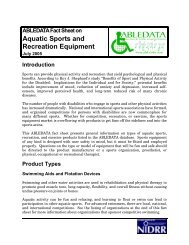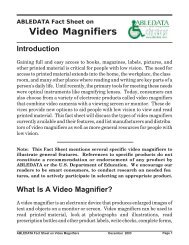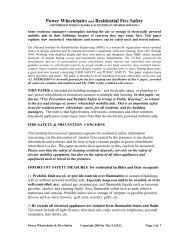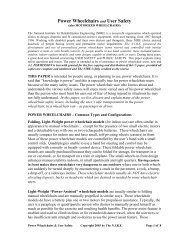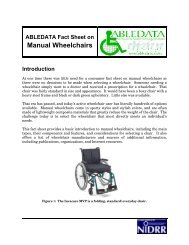Vision Aids for Impaired Peripheral Vision or Tunnel Vision - AbleData
Vision Aids for Impaired Peripheral Vision or Tunnel Vision - AbleData
Vision Aids for Impaired Peripheral Vision or Tunnel Vision - AbleData
Create successful ePaper yourself
Turn your PDF publications into a flip-book with our unique Google optimized e-Paper software.
In Figure 2, above, the circle on each lens represents the objective lens <strong>or</strong> faceplate of a<br />
tubular field expander. A wide-angle, minified image appears on each of the faceplates.<br />
In designing these eyeglasses <strong>f<strong>or</strong></strong> a particular individual, imp<strong>or</strong>tant choices have to be<br />
made as to the characteristics of the FX devices to be used. It greatly helps to have<br />
sample devices on hand <strong>f<strong>or</strong></strong> comparative testing by each patient, in a trial frame.<br />
FX Choices include: (1) Maximum Diameter of Faceplate: this always depends on the<br />
user’s unaided visual field width. Each faceplate should be the widest diameter possible<br />
with the eye being able to see all of the faceplate at the same time. A person having an<br />
unaided field width of 75 degrees should have a wider faceplate diameter than a person<br />
having an unaided field width of only 20 degrees. (2) Overall Width of the Surroundings<br />
to be Displayed … and (3) Linearity of Minified Image. The<strong>or</strong>etically, the outside<br />
viewing angle can be set to any of these values: 180, 140, 120, 90 <strong>or</strong> 60 degrees.<br />
Linearity is either “Linear” <strong>or</strong> “Non-Linear”… where “Linear” means the image is<br />
minified with very little dist<strong>or</strong>tion. “Non-Linear” can show a wider outside angle but has<br />
a lot of dist<strong>or</strong>tion in the viewed minified image. “Linear” is preferred but requires the<br />
user to have a wider unaided field angle and it yields a narrower outside view than would<br />
a non-linear FX device.<br />
Each TV-2A tubular FX is mounted toward the outside of the lens and is angled outward.<br />
The user sees through one <strong>or</strong> the other FX at a given time. Which one is determined by<br />
whether he looks left <strong>or</strong> right. He never sees through both at the same time. Using this<br />
design approach, a person can have smaller angle images that are larger and clearer, and<br />
still see almost directly to the side. Consider these possible alternatives:<br />
1. A non-linear, reduced-size image showing 140 degrees – if the tube were straight,<br />
not angled toward the side. This image could be useless to a person with greatly<br />
reduced acuity. To a person having n<strong>or</strong>mal acuity, the edges of the image are<br />
smaller than the center of the image. Yet, it is the edge (off-to-the-side) image<br />
in<strong>f<strong>or</strong></strong>mation that one needs to see clearly. F<strong>or</strong> a person having n<strong>or</strong>mal acuity, this<br />
type and size FX device helps mostly <strong>f<strong>or</strong></strong> walking and seeing nearby objects. This<br />
type FX might be a commercially made “thru-the-do<strong>or</strong>” wide-angle people<br />
viewer. These can be purchased with diameters of 1/4 <strong>or</strong> 3/8 <strong>or</strong> 1/2 <strong>or</strong> 3/4 inch …<br />
<strong>f<strong>or</strong></strong> different faceplate sizes. All use non-linear minification. Focus is usually<br />
adjustable by setting the length when mounting the device. With a 140 degree FX,<br />
the user might see objects as far as 70 degrees to his side, but only close objects<br />
because of the excessive minification and image dist<strong>or</strong>tion. Non-linear FX<br />
devices are useful mostly to users having excellent acuity and desiring the widest<br />
possible aided field of vision.<br />
2. A linear, reduced-size image showing 60 degrees – with the tube angled toward<br />
the side as shown in Figure 2 can be far m<strong>or</strong>e useful. Due to its being angled<br />
toward the side, it can enable the user to see as far as 70, 80 <strong>or</strong> even 90 degrees<br />
toward the side – but with an undist<strong>or</strong>ted linear image where even moderately<br />
distant objects can be recognizable. This type FX might be a custom made 2x, 3x<br />
<strong>or</strong> 4x biotic low-vision “telescope” mounted in reverse so as to minify rather than<br />
magnify. These devices can be <strong>or</strong>dered from the labs that make them, in different<br />
diameters. Some have focus adjustments but some must be constructed with an Rx<br />
8 <strong>Tunnel</strong> <strong>Vision</strong> Copyright 2003 by The N.I.R.E. Page 8 of 13



